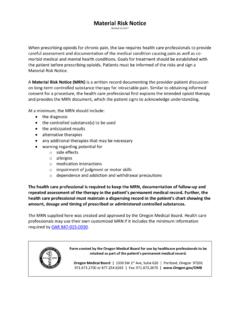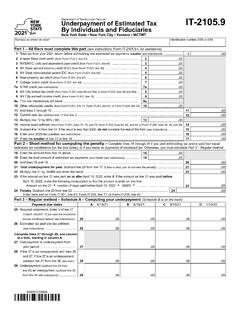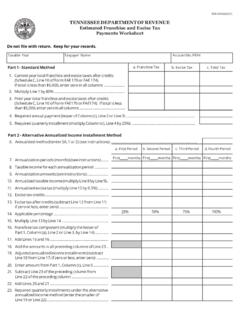Transcription of 2022 Publication OR-ESTIMATE, Oregon Estimated Income …
1 150-101-026 (Rev. 10-13-21) 1 of 62022 Publication OR-ESTIMATET hese instructions aren t a complete statement of laws and Department of Revenue rules. Contact us if you need more information. See the last page for contact tax: The amount of tax, after all credits, that you expect will be shown on your Oregon Income tax return. Estimated tax payment: An annual payment or an install-ment payment that you may be required to make during the tax : Calculation for determining required Estimated payments if you don t receive your Income evenly through-out the year or if you re a part-year credits: Amounts that reduce your tax liability. Nonre-fundable credits, like the personal exemption credit, may reduce your tax liability to zero.
2 Refundable credits may reduce your tax liability below zero, with any amount below zero treated the same as an overpayment of paid: Total withholding, refundable credits, and esti-mated and other tax payments claimed on your or refund: When the amount of tax paid is more than the tax after all credits shown on your return. Applied refund: An overpayment of tax that you choose to apply as an Estimated payment against a later year s tax. underpayment : When your tax paid is less than the tax after all credits shown on your return. underpayment interest: The amount of interest charged on your underpayment if required payments aren t annual payment: The total amount of all tax pay-ments, including Estimated tax payments, withholding, and applied refunds, that you must make by the required due dates in order to avoid being charged underpayment : A tax payment made on your behalf by an employer or payer who is required by law to withhold tax from your Income when they pay you.
3 Employers outside Oregon may withhold tax as a courtesy, but are not required to do tax payments aren t a substitute for withholding. If you aren t having enough tax withheld from your wages or other payments, ask your employer or payer to increase your Oregon withholding. Use Form OR-W-4 to change your Oregon allowances or request an additional amount to be withheld from each payment. You can use our withholding calculator at The calculator can help you determine the correct number of allowances to claim and additional amounts to be withheld. Comparison to federal Estimated taxOregon s Estimated tax system is similar to the federal sys-tem, except that you: Use Oregon s Income tax laws and tax rates. Don t include Social Security tax (FICA), self-employment tax, or household employment tax in your the federal system, estates and trusts are not required to make Oregon Estimated tax payments.
4 Oregon also treats farmers and commercial fishermen differently; see below. Do I have to make Oregon Estimated tax payments?In generalIn most cases, you must make Estimated tax payments for tax year 2022 if: You estimate that your tax after withholding and credits (including refundable credits) will be $1,000 or more when you file your 2022 Oregon return; and Your Estimated withholding for 2022 will be less than: Ninety percent of your 2022 tax after all credits; or One hundred percent of the tax after all credits shown on your 2021 return; or Ninety percent of the tax on your 2022 annualized can still make Estimated tax payments even if you expect that your tax after all credits will be less than $1, you re retired or will retire in 2022, you may need to make Estimated tax payments or have Oregon Income tax withheld from your retirement Income .
5 Contact the payer of your retirement Income to see if withholding is you re a retiree who is domiciled in Oregon , but you file a nonresident return because you re living in another state, your retirement Income may be subject to Oregon Income tax. If you re not domiciled in Oregon , federal law prohibits Oregon from taxing your retirement Income . See Publication OR-17 for more information about residency, domicile, and retirement retirees. If you retired from government ser-vice before October 1, 1991, you don t need to make Oregon Estimated tax payments on your federal pension. If your federal service was both before and after October 1, 1991, you may be required to make Estimated tax payments based on the portion of your federal pension received for service performed after October 1, Estimated Income Tax InstructionsPublication OR-ESTIMATE150-101-026 (Rev.)
6 10-13-21) 2 of 62022 Publication OR-ESTIMATER esidencyNonresidents and part-year residents. If you re a nonresi-dent, estimate your tax only on Income from Oregon sources, such as: Compensation for personal services performed in Oregon . Income from conducting a trade or business within Ore-gon, including property rentals. Capital or other gains from the sale or exchange of Oregon property. Income from intangible property used in connection with an Oregon trade or business. Single-ticket Oregon lottery winnings between $600 $1, : Single-ticket winnings of $1,500 or more are subject to Oregon you ll file as a part-year resident in 2022, estimate Oregon tax on all Income for the part of the year that you ll be a resident, and in the same manner as a nonresident for the rest of the year.
7 Nonresident aliens. If you re a nonresident alien, you have the same Estimated tax payment requirements as citi-zens and resident aliens, whether you re an Oregon resident or nonresident. If you re married and you or your spouse are a nonresident alien, you must make separate Estimated tax entity (PTE) owners. Estimate the tax on your share of Oregon -source Income to be reported by the PTE and on any guaranteed payments you ll receive. Guaranteed payments should be apportioned using the PTE s Oregon apportionment : A PTE may have to file a composite return, withhold tax, or make Estimated tax payments on behalf of one or more nonresident owners. See Publication OR-19 or the instructions for Form for farmers and commercial fishermenIf your gross Income from farming or fishing, including oyster farming, was at least two-thirds of the gross Income shown on your 2021 return, or will be at least two-thirds of your Estimated gross Income for 2022, you don t have to make Oregon Estimated tax payments.
8 Gross Income . Gross Income generally includes all Income you receive during the year, such as wages, interest and divi-dends. Along with your gross profit from fishing or farming, it also includes your gross profit from rentals, royalties, busi-nesses, capital gains, and the sale of property. When figuring your gross profit, don t deduct any expenses except for cost of goods sold (COGS).Gross Income doesn t include Income that Oregon doesn t tax, like Social Security or Railroad Retirement Board ben-efits or welfare Income from farming or fishing. Use the following amounts from your 2021 federal return to determine your gross Income from farming or fishing: Schedule C, line 5. Schedule E, line 42. Schedule F, line 9. Form 4797, line 20.
9 Include only sales of draft, breeding, sporting, or dairy 1: Fishing Income . Felicia, a California resident, operates a commercial fishing business on the Southern Oregon coast. The gross profit from her Oregon fishing business in 2021 was $50,000. The rest of her Income was from California sources other than fishing. Her total gross Income from all sources in 2021 was $90,000. She estimates that her Income will be the same in 2022. Because Felicia s gross Income from her Oregon fishing business is less than two-thirds of her total gross Income , she doesn t qualify for the exception for farmers and fishermen. Example 2: Farming Income . Vern is a farmer. Julie is a wage earner and an artist. They file jointly and want to know if they must pay Estimated tax for 2022.
10 Vern and Julie estimate that their gross Income in 2022 will be about the same as it was in 2021. Their 2021 federal return shows the following:Wages $25,000 Business loss 1,500 Farm Income 18,500 Adjusted gross Income $42,000 Vern s farming Income , Schedule F:Gross crop sales $10,000 Gross livestock sales 17,000 Farm gross Income $27,000 Total expenses 8,500 Net farm profit $18,500 Julie s business Income , Schedule C:Gross receipts $20,000 COGS 12,000 Gross Income after COGS 8,000 Total expenses 9,500 Net Schedule C business loss $1,500 Their gross Income :Wage Income $25,000 Farm gross Income 27,000 Business gross Income after COGS 8,000 Total gross Income $60,000 Two-thirds of Vern and Julie s gross Income is $40,000 ($60,000 x ).















